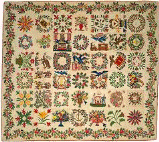
Textile Society of America
Textile Society of America: Symposium Proceedings
2024:
2020:
2018:
2016:
2014:
2012:
2010:
2008:
2006:
2004:
2002:
2000:
1998:
1996:
1994:
1992:
1990:
1988:
2016
“The British are coming! A contraband cloth tsunami flows over Maya handicrafts and homespun in The Kingdom of Guatemala, 1760-1820”, Heather J. Chiero
America’s Indigo Obsession: From Colonial Plantations to Contemporary DIY Ethos, Sonja Dahl
Mexican ikat and transatlantic trade, Alejandro B. de Avila
On Textile Fragments Found at Karadong, a 3rd to early 4th Century Oasis in the Taklamakan Desert (Xinjiang, China), Sophie Desrosiers and Corinne Debaine-Francfort
Dyeing with Morinda citrifolia: In Pursuit of Sustainable future, Sudha Dhingra
Exploring Color Interactions Illuminated in Goldwork Embroidery, Katherine Diuguid
Title: AJRAKH- A Textile Tradition in Transition, Sharmila J. Dua Prof. Dr.
Lasting impressions: Indian block-prints and global trade, Eiluned Edwards
Applications of Cross Dyeing with Natural Dyes, Catharine Ellis
The fashion diplomacy and trade of Kashmir shawls: Conversations with shawl artisans, designers and collectors., Deborah Emmett
Veiled in Ignorance and Clothed in Reason: Jimmie Durham’s 2014 Exhibition Traces and Shiny Evidence, Andrea Feeser
Resilient Threads Telling Our Stories Hilos Resilientes Cosiendo Nuestras Historias, Carolina Paz Gana and Lynne M. Jenkins
Sacred Currency: The Value of Textile in Colonial Andean Painting, Gaby Greenlee
The Changing Role of Chaguar Textiles in the Lives of the Wichí, an Indigenous People of Argentina, Rachel Green
The Effect of Colonization and Globalization in the shaping of Phulkari: A case study of the Textiles of Punjab, India, Anu H. Gupta and Shalina Mehta
Seafarer People and their Textiles from Erub Arts, Torres Strait, Australia, Louise Hamby and Valerie Kirk
Batik, ja, batik: Wiener Werkstätte Batik from the Los Angeles County Museum of Art and Cotsen Textile Traces Collections, Michaela Hansen
Kashmir Shawls: The Perfect Exemplar of a Textile Shaping and Being Shaped, Joan Hart
Ingenious and practical; parallels in the making of Arimatsu trade cloth and contemporary designers’ production, Ana Lisa Hedstrom
Here and there, now, Sandra Heffernan
New Tools in the Box: Traditional Methods, Contemporary Materials and New Techniques on the Atlantic Coast A Round Table Discussion, Memory Holloway and Laurie Carlson Steger
Recycling Sprang, Carol James
Drawing, Stitch, Translation, Archive, Janis Jefferies
Aesthetics, Economics and the Enchantment of Cloth, Janis Jefferies and Barbara Layne
Textile Art as a Locus of Colonization and Globalization: The Tapestry Project, EunKyung Jeong MFA, Ph.D.
Imperial versus local perceptions of Indian textiles, Donald Clay Clay Johnson
Performance, Adaptation, Identity: Cantonese Opera Costumes in Vancouver, Canada, Jean L. Kares
Shifu: A Traditional Paper Textile of Japan, Hiroko Karuno
The Story and the Stitch., Alice Kettle
"Knit a Bit for Our First Line of Defense": Emotional Labor, Knitters, and Comforts for Soldiers during the First World War, Rebecca Keyel
For What It’s Worth: The French Knot as a Basic Trade Commodity, Jeana Eve Klein
Byzantine and Oriental silks from a Royal Shrine in Denmark AD 1100, Anne Hedeager Krag
The Power of Color: Anatolian Kilims, Sumru Belger Krody
Drawloom Velvet: Exploring a Centuries Old Tradition, Wendy Landry
The Intercontinental Reflections of an Eighteenth-Century Mexican Rebozo, Eleanor A. Laughlin
Sumptuary Synergy: British Imperialism Through the Tartan and Slave Trades, David Loranger and Eulanda A. Sanders
“Meshed with a Million Veins”: Seafaring Networks & the Norfolk Sampler, Joanne Martin Lukacher
Cutting edge technology: knitting in the early modern era, Jane Malcolm-Davies Dr.
The Legacy of Yarn Dyed Cotton Lungis of Cuddalore, Tamil Nadu: A Case Study, Vasantha M. Dr.
FROM CHINTZ TO CHITA: A BRAZILIAN TEXTILE AND THE CONSTRUCTION OF NATIONAL IDENTITY, Willian Nassu
Velvet and Patronage: The Origin and Historical Background of Ottoman and Italian Velvets, Sumiyo Okumura Dr.
Revitalization of the Handloom Heritage of Chhota Udepur, Gujarat, Bhatia Reena PhD. and Pawar Pooja M.Sc.
Revitalization of the Handloom Heritage of Chhota Udepur, Gujarat, Bhatia Reena PhD. and Pawar Pooja
West African Indigo Textiles under Influences: The Fouta-Djallon Wrapper and the Mauritanian Melhafa, Annie Ringuede
Sadu Weaving: the pace of a camel in a fast-moving culture, Lesli Robertson
Imagining Conquest: El Tapiz and Postrevolutionary Mexico*, Regina A. Root
A Morenada Dance Costume: An Example of the Interconnection of the Americas, Spain and Africa, Nancy B. Rosoff
Kanga Textile Design, Education, and Production in contemporary Dar es Salaam, Tanzania, MacKenzie Moon Ryan PhD.
Engineered Ikat Textile of Gujarat - A Design Intervention, Shohrat S. Saiyed and Reena Bhatia Ph.D.
“The Consular Collections at the National Museum of American History” Opening Plenary Session: Crosscurrents: the Transnational Flows of Textiles, Madelyn Shaw and Amy J. Anderson
The Textile Artist’s Archive: Approaches to Creating, Collecting and Preserving Artistic Legacy, Jessica Shaykett, Kathleen Mangan, Lia Cook, Stephanie Zollinger Dr., and Fannie Ouyang
Importing Irish Linen and Creating American ‘Art Moderne’: An Analysis of an Early 20th Century Trade Catalog, Lacy Simkowitz
Mending as Metaphor: Finding Community Through Slow Stitching in a Fast Paced World, Ruth Katzenstein Souza
EXPLORING ORIGINS: THE TECHNICAL ANALYSIS OF TWO YORUBA MASQUERADE COSTUMES AT THE NATIONAL MUSEUM OF AFRICAN ART, Rebecca Summerour and Odile Madden
Artist at Sea: Codes and Cargo, Kelly Thompson
The Merchants and the Dyers: The Rise of a Dyeing Service Industry in Massachusetts and New York 1800-1850, Linda Jean Thorsen
Tablet Weaving in Myanmar, Tomoko Torimaru
SOME NATIONAL GOODS IN 1871: THE REBOZO, Marta Turok
Early Modern Needlework Pattern Books: Tracing the International Exchange of Design, Lisa VandenBerghe
The Nature of Collaboration in the Digital Age, Pauline Verbeek-Cowart
Slipstitch: a survey of contemporary narrative-based stitch and embroidery practices in Australia, Belinda Von Mengersen
Arimatsu to Africa: Shibori Textiles Developed for African Trade in 1948–49, Yoshiko Iwamoto Wada
Kalamkari or Chintz: An Anglo-Indian Hanging in The Metropolitan Museum of Art, Melinda Watt
Trading Traditions: Continuity, Innovation and Resource Use of Forest Fibers Among the Ye’kwana and Ayoréode, Laurie Wilkins and Ines Hinojosa
Tracing textiles, motifs and patterns: historical to contemporary, Liz Williamson
From Function to Fashion to a Contemporary Art Process, Journey’s Within a Fisherman’s Rib Jumper, Christine Wiltshier
Tradition and Transition: The changing fortunes of barkcloth in Uganda, Sarah Worden
Some of the Weavings Used in Turkish Bath in the Context of Intangible Cultural Heritage, Ayşem Yanar, Feryal Söylemezoğlu, Zeynep Erdoğan, and Özlen Özgen
Non-specific: ubiquity, invisible labor and the moving blanket, Callen Zimmerman
2014
2014 Biennial Symposium: New Directions: Examining the Past, Creating the Future (website home-page)
Abstracts and Presenter Biographies from 14th Biennial
Biennial Symposium Proceedings: Abstracts & Biographies
Rethinking the Tiwanaku Phenomenon in San Pedro de Atacama Through the Study of Textiles of Solcor 3 and Their Associated Contexts (400-1000 AD), Carolina Aguero and Mauricio Uribe
Pulling Strings: Textiles, Community and DIY in Post-Industrial Hamilton, Jen Anisef, Thea Haines, and Tara Bursey
Textiles and Museum Displays: Visible and Invisible Dimensions, Ruth Barnes
A New Unit for Study and Research The Textile Museum and the George Washington University in Washington, D.C, Sumru Belger Krody
Adinkra and Kente Cloth in History, Law, and Life, Boatema Boateng
Interwoven Connections: Examining the History of Scottish Carpet Design to Inform future Learning, Teaching and Research, Helena Britt
Substitute Innovation: Rethinking the Failure of Mid-Twentieth Century Regenerated Protein Fibres and their Legacy, Mary M. Brooks
The Obiko Archive, Jean Cacicedo and Ana Lisa Hedstrom
REMATERIALIZING: Interviews with Emerging Artists About Physicality, Pattern and Textile Techniques, Caroline Hayes Charuk
Maguey Hammock: A Weaving of Resistance and Persistence in Puerto Rico, Soraya Serra Collazo
Natural Dyes and Aesthetic Search, María Dávila and Eduardo Portillo
Stitches of War: Women’s Commentaries on Conflict in Latin America, Deborah A. Deacon
Highland Complementary-Warp Weaving and the Lima Style in the Central Coast of Peru, ca. 200-650 C.E., Sophie Desrosiers
Writing Textile, Making Text: Cloth and Stitch as Agency for Disorderly Text, Catherine Dormor
Communicating Textiles Within and Beyond Museum Walls: New Directions, Dinah Eastop
Reflecting on Collecting: My Romance with African Textiles, Joanne B. Eicher and Diana Eicher
Conversations Between a Foreign Designer and Traditional Textile Artisans in India: Design Collaborations from the Artisan’s Perspective, Deborah Emmett
Before there was Pinterest: Textile Study Rooms in North American “Art” Museums, Sarah Fee
Traditional Textile Design for Social Innovation Toward Sustainability in Japan, Yuko Fukatsu
Wikispaces: Technology, Textiles, and Public Engagement, Blaire O. Gagnon
Integrating the Evidence: Historic Silk Production in Context, Julia Galliker
A Fragmented Treasure on Display: The Turfan Textile Collection and the Humboldt Forum, Mariachiara Gasparini
The Fabric for a City: Development of Textile Materials During the Urbanization Period in Mediterranean Europe, Margarita Gleba
Threads of Feeling: Embroidering Craftivism to Protest the Disappearances and Deaths in the “War on Drugs” in Mexico, Maureen Daly Goggin
Innovation and Preservation of Manichaean Textiles In Southern Costal China in the 17th – 20th Centuries, Gloria Granz Gonick
Textile Materials and Techniques in Central Europe in the 2nd and 1st Millennia BC, Karina Grömer
New Directions in Australian Aboriginal Fabric Printing, Louise Hamby and Valerie Kirk

